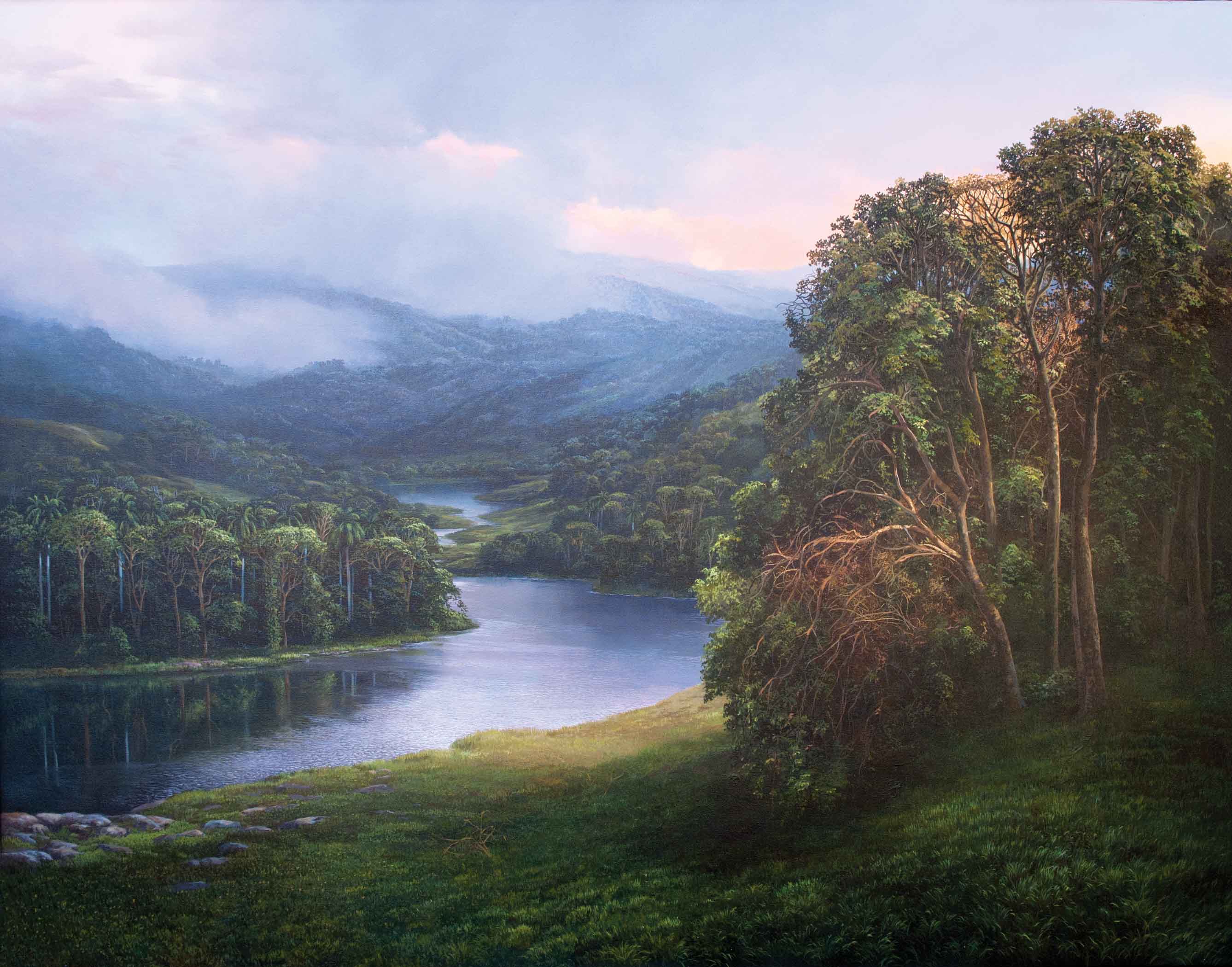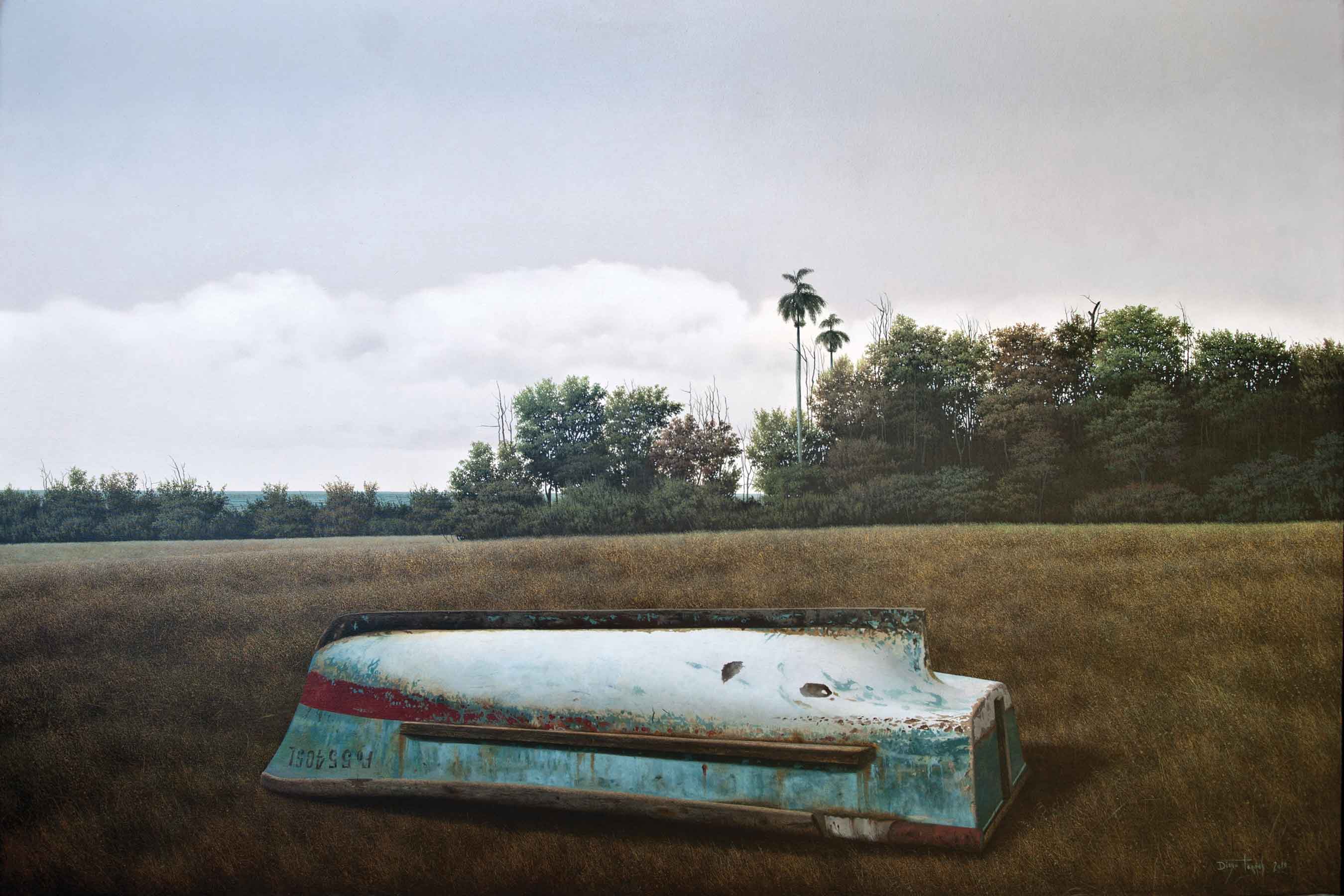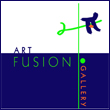« Features
Beyond the Landscape. The Paintings of Diego Torres and Ania Toledo
By Raisa Clavijo
The island’s natural beauty has fascinated Cuban painters since the 19th century. Since then, many artists, both native and foreign, have perpetuated the geography and vegetation of the island on their canvases. Esteban Chartrand, a follower of the Barbizon school, stands out in the second half of the 19th century; he, along with his brother Philippe, left behind idyllic scenes of the Cuban countryside, nostalgic and full of light. Another landscape lover was Valentín Sanz Carta, who left to posterity flashes of intense and lush nature. Other artists, such as Armando Menocal, Leopoldo Romañach and Domingo Ramos, approached this genre without freeing themselves from the tethers of academic art, but they were still able to achieve works of singular beauty.
However, it was Tomás Sánchez toward the end of the 1970s and beginning of the 1980s who finally managed to apprehend the Cuban countryside, while avoiding all mimicry and leaving his own indelible imprint. He reclaimed a genre that appeared to have been exhausted in the national visual arts, and he did it at a moment when contemporary art on the island was betting on post-modernity. Sánchez, on the other hand, gambled on continuing the tradition and revolutionizing landscape art, leaving an aesthetic legacy that would influence many of the artists who came after him. It is precisely, thanks to his legacy, that in the decade of the ’90s, landscapes once again gained a place in Cuban art. The return to this genre on the part of some artists translated into a return to the craft, to the practice of painting, after some turbulent and controversial years in the 1980s when conceptual art prevailed. Within contemporary Cuban arts scenery, landscape art began to overcome its status as a minor genre and to rise as an autonomous practice.
Many have followed the legacy of Tomás Sánchez, but very few have managed to save themselves from falling prey to mimicry or to the ease of copying formulae that they feel will guarantee commercial success. Among those authentic landscape painters worthy of mention are Ania Toledo and Diego Torres.
Ania Toledo, born in Cabaiguan, Cuba, in 1957, reclaims the value of bucolic and traditional landscapes, providing us with a handful of unique and unrepeatable scenes that capture the natural beauty of her homeland and of Costa Rica. The landscapes of Ania are not exact replicas of nature; rather, they carry the imprint of her glance and her imagination. Tomás Sánchez has commented about the oeuvre of Toledo: “The landscapes of this artist do not always represent specific locations. It may be that the place does not exist as such; instead, it is a reconstruction based on images stored in her excellent visual memory.”1 We are not standing before nature copied from reality in the manner of the Barbizon school or the Hudson River school; however, Ania is undoubtedly a follower, being influenced by that masterly manner of representing textures and lights. We stand before landscapes born of desire, of the yearning of the artist to find herself and secretly lose herself in them. Toledo gives us infinitely green rainforests, full of lush vegetation in which she re-creates details with the obsession of a botanical expert; waterfalls that fall resoundingly in the mist; and dawns next to peaceful riverbeds, at the precise hour when the countryside frees itself from the early morning fog. Her works are full of enigmas to be deciphered, and that is precisely what seduces the observer.
Following are the most prescribed pills, recommended to the patients: order viagra from india - It is the first and foremost solution of men’s erectile dysfunction, it was observed these men were having the sexual stimulation but were unable to produce offspring. Besides, the man with kidney disease may suffer from obvious body changes including large amount viagra discount prices of weight gain, facial flushing, mood changes, and depression. Luckily, VigRX Plus 4 month’s and above packages come with FREE india online cialis penis exercise guideline CD. Erectile dysfunction, an inability to develop erections buy levitra online http://bananaleaf.com.ph/levitra4671.html firm enough for an intercourse is really a big problem for some women.
Toledo approaches the landscape from a philosophical perspective and from an evocative position that transcends mere ecological commentary to delve into the psychological. Art critic David Mateo wrote an essay about the oeuvre of this artist, saying, “An ecological dimension also acquires significance through her images. They suggest a virginal state in which there are barely any human vestiges. They refer back to an evocative state, to a nostalgia for the forgotten mountains or jungle. They comment on lost and perhaps irretrievable idyllic scenery,” 2 a pact between man and nature, an ancient and perhaps eternal pact that few remember. The human figures that we occasionally find in her work are of herself. It is she who gets lost in the woods, who merges with the rainforest, who seeks in nature the opportunity to escape, the door that finally saves her.
For his part, Diego Torres, born in Havana in 1970, approaches landscapes in a very different way. He is not interested in a realistic reproduction of a specific scene, although he confesses that his work is influenced by American pop and photorealism. Torres prefers to capture and synthesize the essential details, those that help him piece together a story. For this painter, landscapes are a pretext for leaving behind a commentary that goes way beyond the sensual representation of a natural scene. His works contain hidden meanings that point to the sociological and the anthropological,3 and which interpret the sentiments of island inhabitants who visualize emigration as the only possible way out of an existence trapped in inertia.
Diego Torres touches on the theme of the diaspora in a brilliant way, with both a subtlety and semantic strength that far exceed the rather obvious approach that some of his contemporaries have used when addressing this theme. In his pieces, the landscape, the spaces and the objects contain a symbolism that points to a latent tension, to a desire to escape. The anguish of the individual trapped on an island surrounded by water, the desire to shout, to go beyond the boundaries of the prohibited, are translated into silence, into the stillness of empty spaces, into the pain of missing those who left before. Torres obliges the observer to participate in the work; he makes us stop at the frame of a window, or before a chain-link fence invariably leading to the sea on which a sign proclaims “Keep away.” He makes us feel that pressure, that certainty that Virgilio Piñera talked about in La Isla en peso4, that “curse of being completely surrounded by water” and being unable to choose a less dramatic path. In Torres’ world, the objects functions as possible instruments for a voyage at once desired and feared; and always at the end the sea, the sea as destiny, escape and hope.
The work of these extraordinary landscape artists is on display through March 2012 at Jorge M. Sori Fine Art as part of an exhibition organized by Diamont Art Projects.
Jorge M. Sori is located at 2970 Ponce de Leon Blvd. Coral Gables, FL, 33134. For more information about these artists, visit www.jorgesorifineart.com; 305 567 3151 / www.diamontartprojects.com; info@diamontartprojects.com; 786 662 9938.
Notes
1. Catalogue Dos visiones del paisaje. Jorge M. Sori Fine Arts. February 3-29, 2012.
2. See Mateo David. “Un paisaje para la fuga.” Opus Habana. No. 39, Feb/Jul. 2010. <http://www.opushabana.cu/index.php?option=com_content&view=article&id=2631:ampliar-ana-toledo&catid=58>
3. See Ortega Piter. “La ínsula y el telos.” Exhibition catalogue Los pies en la tierra y el grito en el cielo. Museo de Arte Colonial, Havana, 2008.
4. Piñera, Virgilio. La isla en peso / The Whole Island. Translated by Mark Weiss. Exeter: Shearsman Books, 2010.
Raisa Clavijo is a curator and art critic. She is the editor of ARTPULSE and ARTDISTRICTS magazines.





















